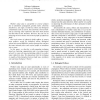Free Online Productivity Tools
i2Speak
i2Symbol
i2OCR
iTex2Img
iWeb2Print
iWeb2Shot
i2Type
iPdf2Split
iPdf2Merge
i2Bopomofo
i2Arabic
i2Style
i2Image
i2PDF
iLatex2Rtf
Sci2ools
FSKD
2009
Springer
2009
Springer
Censoring Biological Echoes in Weather Radar Images
Weather radar data is susceptible to several artifacts due to anamalous propagation, ground clutter, electronic interference, sun angle, second-trip echoes and biological contaminants such as insects, bats and birds. Several methods of censoring radar reÿ˜ectivity data have been devised and described in the literature. However, they all rely on analyzing the local texture and vertical proÿ˜le of reÿ˜ectivity ÿ˜elds. The local texture of reÿ˜ectivity ÿ˜elds sufÿ˜ces to remove most artifacts, except for biological echoes. Biological echoes have proved difÿ˜cult to remove because they can have the same returned power and vertical proÿ˜le as stratiform rain or snow. In this paper, we describe a soft-computing technique based on clustering, segmentation and a two-stage neural network to censor all non-precipitating artifacts in weather radar reÿ˜ectivity data. We demonstrate that the technique is capable of discrimination between light snow, stratiform rain and deep biological ã...
Artificial Intelligence | Biological Echoes | FSKD 2009 | Radar Reÿ˜ectivity Data | Weather Radar |
| Added | 26 May 2010 |
| Updated | 26 May 2010 |
| Type | Conference |
| Year | 2009 |
| Where | FSKD |
| Authors | Valliappa Lakshmanan, Jian Zhang |
Comments (0)

